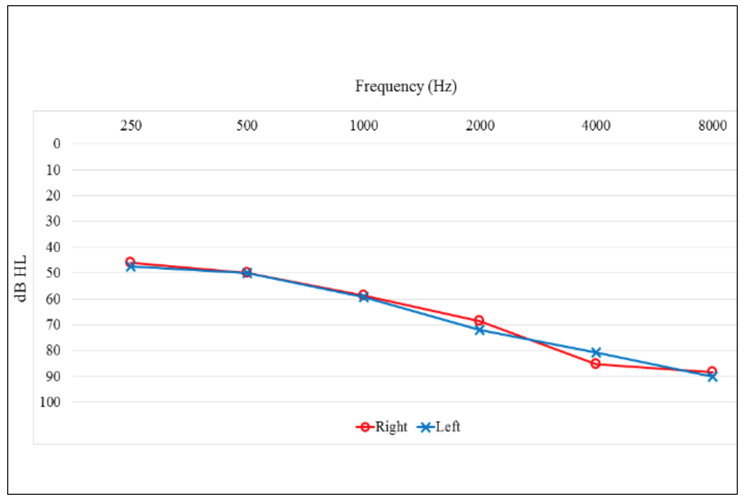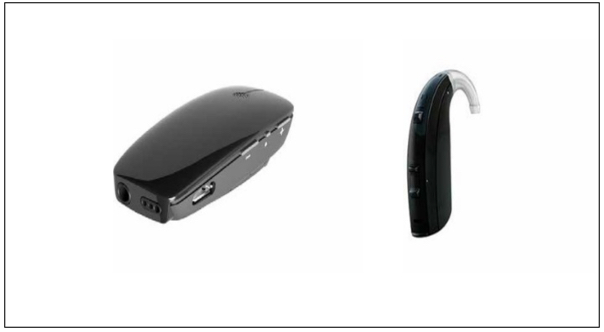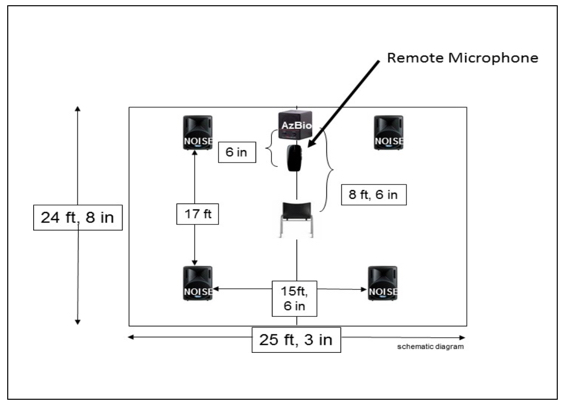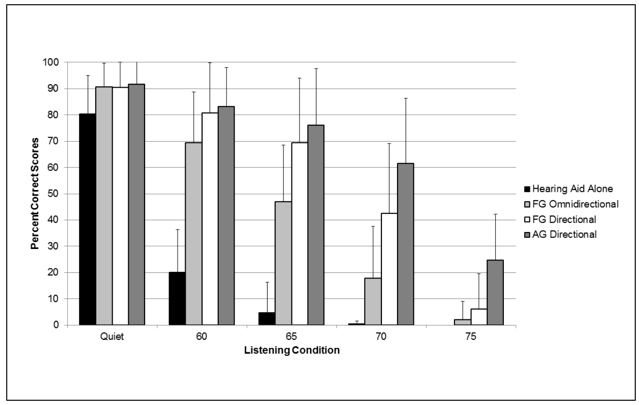Learning Objectives
After this course, participants will be able to:
- Explain the difference between the three different types of remote microphone systems.
- Apply study outcomes and other considerations to select an appropriate remote microphone solution for an individual.
- Name two considerations that could make a fixed gain remote microphone system preferable to an adaptive gain remote microphone system for a given individual.
Introduction
Individuals with hearing loss often struggle to understand speech in the presence of background noise (Bradley & Soto, 2008; Crandell & Smaldino, 2000; Finitzo et al, 2000; Finitzo-Hieber & Tillman, 1978; Jamieson et al, 2004; Wolfe et al., 2013a; 2015). Use of remote microphone technology is the most effective method to improve speech recognition in noise of hearing aid users (Hawkins, 1984; Schafer & Thibodeau, 2004; Wolfe et al., 2009; 2013a; 2013b, 2013c; 2015). Remote microphone systems are comprised of a microphone/radio transmitter unit and radio receiver(s). The microphone is worn in close proximity (6 to 8 inches) to the mouth of the talker of interest. The speech signal captured at the microphone is delivered by the transmitter to the receiver(s) by way of radio frequency (RF) transmission. Then, the receiver delivers the signal to the hearing aids. Remote microphone systems are likely to provide substantial improvement in speech recognition in noisy and reverberant environments and when the signal of interest originates from more than 3 or 4 feet from the hearing aid user.
A variety of different remote microphone systems are available for hearing aid users. Early remote microphone systems were designed to work with the hearing aids of most manufacturers and accordingly can be described as universal systems (although no standard nomenclature exists for labeling modern remote microphone systems). Typically, the RF receiver of a universal system is coupled to the direct auditory input (DAI) by way of an adapter designed for the hearing aid, and as a result, use of the remote microphone system adds extra hardware to the user’s hearing aids. More recently, hearing aid manufacturers have developed remote microphone systems which are designed to work only with the hearing aids of the specific manufacturer and are often referred to as accessory remote microphone systems. Although the cost of remote microphone technologies varies across manufacturers, accessory systems are often less expensive (and in some cases considerably so) than universal systems.
Accessory remote microphone systems also differ in design and application across manufacturers. For instance, some accessory systems may be referred to as truly wireless accessory remote microphone systems, because the RF signal (which is typically a proprietary digital RF signal transmitted at 900 MHz or 2.4 GHz) is delivered from the transmitter directly to receivers that are integrated within the hearing aids. Truly wireless accessory remote microphone systems do not require the use of additional hardware that is coupled to the hearing aids and may consequently be more comfortable, convenient, and cosmetically appealing for the hearing aid user.
Some hearing aid manufacturers have developed remote microphone accessory systems that use an interface device to relay the RF signal from the transmitter to the user’s hearing aids. In short, Bluetooth RF transmission is typically used to deliver the audio signal of interest from the remote microphone to the interface. Then, the signal received at the interface is delivered to the hearing aids via nearfield magnetic induction. The interface device is usually clipped to the hearing aid wearer’s shirt collar or is coupled to a loop that is worn around the neck.
It is possible that the use of the interface device will be perceived as being less comfortable, less convenient, and not as cosmetically appealing when compared to a truly wireless system.
Remote microphone systems also contain a variety of different noise management technologies that are designed to improve speech recognition in noise. For example, remote microphone systems may possess omni-directional microphones or directional microphones. When a directional microphone is located in close proximity to and oriented toward the talker’s mouth, the directional response serves to attenuate surrounding noise more so than the speech of the talker and to consequently provide an improvement in the signal-to-nose ratio (SNR).
Additionally, some remote microphone systems contain gyroscopes and accelerometers in the microphone/transmitter unit allowing for a determination of the orientation of the microphone. When the remote microphone is vertically oriented (i.e., clipped on the talker’s collar or worn on a loop around the talker’s neck; also known as “teacher mode” or “lapel mode”), the system automatically switches to directional mode in an attempt to focus on the speech from the talker’s mouth and attenuate surrounding noise. In contrast, when the remote microphone is oriented in the horizontal plane, as it would if it were lying on a tabletop, the system automatically switches to omni-directional mode to capture all sounds surrounding the microphone.
Furthermore, remote microphone systems may differ in the gain that is applied to the signal that is transmitted from the remote microphone to the hearing aids. The term “receiver gain” refers to the strength of the signal that is delivered from the remote microphone receiver to the hearing aid. With a fixed-gain remote microphone system, the receiver gain remains constant regardless of the ambient noise level. With an adaptive gain remote microphone systems, the receiver gain increases as the ambient noise level increases with the objective of improving the SNR.
This article describes a study in which speech recognition in quiet and in noise was evaluated in four different conditions: 1) hearing aids alone, 2) hearing aids with a fixed- gain remote microphone accessory system with an omnidirectional microphone, 3) hearing aids with a fixed-gain remote microphone accessory system with an automatically-activated directional microphone system, 4) hearing aids with an adaptive-gain, universal remote microphone system with an automatically-activated directional microphone system.

Figure 1. The mean audiometric thresholds of the participants in this study.
Methods
Fifteen adults (18 to 83 years old; mean age = 64.9 years old [standard deviation = 15.4]) with moderate-to-severe hearing loss (unaided four-frequency pure tone average of 40 dBHL or poorer in the better hearing ear) participated in this study (see Figure 1 for the mean audiometric thresholds of the participants in this study). All participants had used binaural hearing aids for at least two years and had an aided CNC word recognition score of at least 50% correct in the binaurally aided condition in quiet (60 dBA presentation level).
All participants used ReSound LiNX² behind-the-ear hearing aids (binaurally fitted) while participating in the study. For all audiometric frequencies at which the air conduction pure tone hearing threshold did not exceed 80 dB HL, the output of each hearing aid was matched to the NAL-NL2 prescriptive target (+/-5dB) for a calibrated speech signal presented at 55, 65, and 75 dB SPL as determined by real ear probe microphone verification. Additionally, the real ear aided response obtained to a swept pure tone presented at 85 dB SPL did not exceed prescriptive targets for maximum output level.
Sentence recognition in quiet and in noise was evaluated in each of four different conditions:
- Hearing aids alone
- Hearing aids with use of the ReSound Mini Mic, which is a truly wireless accessory remote microphone system that contains a fixed-gain receiver and an omni-directional microphone.
- Hearing aids with use of the ReSound Multi Mic (see Figure 2), which is a truly wireless accessory remote microphone system that contains a fixed-gain receiver and an adaptive directional microphone that is automatically enabled when worn in the teacher/lapel mode.
- Hearing aids with use of the Phonak Roger system, which is a universal remote microphone system that contains an adaptive-gain receiver and a transmitter with an adaptive directional microphone that is automatically enabled when worn in the teacher/lapel mode. Specifically, the Phonak Roger Touchscreen remote microphone and Phonak Roger X receivers were used in the “Roger” condition.

Figure 2. ReSound Mini Mic and ReSound LiNX² behind-the-ear hearing aid.
Speech recognition in each of the four technology conditions was evaluated in a classroom-type setting (25’3” by 24’8” by 9' feet; see Figure 3). Speech recognition was evaluated with use of one full list of AzBio sentences (Spahr et al., 2012) per test condition. The AzBio sentences were presented from a loudspeaker located in the front-center of the room, whereas uncorrelated classroom noise (Schafer & Thibodeau, 2006) was presented from four loudspeakers located in the corners of the classroom (30,150, 210, and 330 degrees azimuth relative to the location of the participant; see Figure 3). For each technology condition, sentence recognition was evaluated in quiet and in noise presented 60, 65, 70, and 75 dBA. In the remote microphone conditions, the remote microphone was positioned 6 inches directly below the cone of the loudspeaker. The level of the AzBio sentences was 85 dBA at the location of the remote microphone and 65 dBA at the location of the participant.

Figure 3. Loudspeaker presentations in the corners of the classroom (30,150, 210, and 330 degrees azimuth relative to the location of the participant).
Results
The data were analyzed with a two-factor repeated measures analysis of variance (RM ANOVA) with the factors of SNR condition (quiet, and noise at 60, 65, 70, and 75 dBA) and technology condition (hearing aid alone, ReSound Mini Mic, ReSound Multi Mic, and Phonak Roger). Mean speech recognition results across the SNR and technology conditions are shown in Figure 4. The RM ANOVA identified statistically significant differences across SNR (p < .01) and technology (p < .01) conditions as well as a statistically significant interaction between the SNR and technology conditions (p <.01).

Figure 4. Mean speech recognition results across the SNR and technology conditions.
Post-hoc analyses conducted with the Tukey-Kramer Multiple Comparisons test identified the following findings:
- Use of each remote microphone system provided better speech recognition in quiet and in noise relative to the hearing aid alone condition.
- At moderate to high noise levels (60-75dBA), the remote microphone systems with directional microphones (i.e., ReSound Multi Mic and Phonak Roger) provided better speech recognition in noise than the remote microphone system with an omni-directional microphone (ReSound Mini Mic).
- At higher competing noise levels (70 and 75 dBA), use of an adaptive-gain remote microphone system provided better speech recognition than what was obtained with use of a fixed-gain remote microphone system.
Discussion
The results of this study provide evidence of the substantial benefit provided by use of remote microphone technology. Use of each of the remote microphone systems resulted in a trend toward an improvement in sentence recognition in quiet relative to the hearing aid alone condition. In noise, use of a remote microphone system provided improvement in speech recognition of up to almost 70 percentage points compared to use of hearing aids alone. Inclusion of a directional microphone in the remote microphone system attenuates surrounding noise resulting in an improvement in the SNR and a consequent improvement in speech recognition in noise, particularly at moderate to high noise levels (i.e., 65 to 70dBA).
At higher noise levels (i.e., 70-75 dBA), the provision of adaptive increases in receiver gain provides an improvement in speech recognition (typically almost 20 percentage points compared to a fixed-gain receiver). Of note, the Roger X receiver (or any universal remote microphone receiver that contains a 3-prong Europort plug) may be directly connected to the Europort socket of the ReSound Multi Mic. This solution may be beneficial for children who are using ReSound hearing aids and are educated in a classroom in which a universal remote microphone system is already in use. Connecting the universal receiver to the ReSound Multi Mic allows the child to have access to the signal being broadcast by the universal remote microphone system, and only one universal receiver is required for delivery of the remote microphone signal to both hearing aids of a binaural user by way of the Multi Mic to the integrated RF receivers. A previous ReSound white paper described an investigation in which electroacoustic measurements suggested preservation of the adaptive gain benefits of the Roger system when the Roger X receiver was coupled to the Multi Mic (Quilter and Wright, 2017).
However, it is important to note that there have been no studies examining speech recognition obtained with the use of adaptive-gain RF receivers coupled directly to hearing aids versus an adaptive-gain receiver coupled to the Multi Mic.
Several factors influence the selection of a remote microphone system that best meets the needs of each hearing aid user. For instance, hearing aid users may select a remote microphone system based on financial cost. Accessory remote microphone systems are typically less expensive than universal remote microphone systems and will often serve as an excellent option for persons who cannot afford the relatively higher cost that is often associated with wireless universal remote microphone systems. Accessory remote microphone systems with automatically-enabled directional microphones may be of particular interest to many hearing aid users given the relatively good speech recognition in noise that may be obtained at a relatively affordable cost.
Additionally, some hearing aid wearers may not wish to connect an RF receiver to their hearing aids. The coupling of a radio receiver to an adapter that connects to the DAI of the hearing aid adds extra bulk and weight to the hearing aid. For the bilaterally fit hearing aid wearer, it would be necessary to have a receiver and adaptor on each hearing aid in order to receive the signal and benefit in both ears. Furthermore, some hearing aid wearers may prefer the cosmetics of a hearing aid that contains an RF receiver that is integrated within the hearing aid rather than coupling a universal receiver to their hearing aid.
Remote microphone systems with directional microphones and adaptive-gain receivers may be the ideal solution for persons who require optimal improvement in the SNR in order to understand speech in moderate-to-high-level noise. Also, remote microphone systems with directional microphones and adaptive-gain receivers are likely to be ideal for persons who frequently communicate in environments with high-level noise (70-75 dBA). The clinician should work with the hearing aid wearer (and his/her family) to evaluate the cost/benefit relationship of various remote microphone systems with the objective of determining the remote microphone system that best meets the needs of each individual.
Of note, the clinician should also consider other practical features that may influence the benefit the user will receive from remote microphone technology. For example, some remote microphone systems may be simpler to operate than others. The clinician should ensure that the user (and his/her caregiver if the user is a child) are comfortable operating the remote microphone system that is recommended for the user. Ideally, the clinician should plan to spend ample time with the user discussing proper care, use, and maintenance of the remote microphone system.
Moreover, the clinician should consider whether the user will be able to manually activate the remote microphone system or if automatic-activation is ideal. In particular, children are unlikely to consistently press a button on their hearing aids or on a remote control to activate the remote microphone system during times in which a signal of interest is present at the remote microphone. Remote microphone systems that automatically enable when the remote microphone is active are likely to be preferred for infants and young children who cannot manually operate their hearing aids. However, the child’s caregiver (e.g., parent, teacher, etc.) must be cognizant of the need to mute the remote microphone when the child is listening to other signals of interest (e.g., a child working in a small group in a classroom while his/her teacher works with another small group). The availability of a remote microphone that contains a display screen or that may be wirelessly connected to a smartphone or tablet via an app is likely to be beneficial, because information regarding the function of the remote microphone system may be provided to the hearing aid user and/or his/her caregivers (e.g., the remote microphone is enabled/disabled, the user is outside the range of the remote microphone, etc.).
Finally, it is strongly recommended that clinicians should select a remote microphone system that allows for the connection of the remote microphone transmitter to consumer electronics such as a classroom smartboard, a computer, a television, etc. This greatly expands the scope of the benefit of the remote microphone system beyond listening to talkers in difficult listening situations.
Conclusions
- Use of remote microphone systems provides substantial improvement in speech recognition over hearing aids alone.
- Several factors must be considered when selecting the ideal remote microphone system for each individual.
- Remote microphone systems with directional microphones provide better speech recognition in noise than remote microphone systems with omni-directional microphones.
- Remote microphones systems with adaptive-gain receivers provide better speech recognition in high level noise than remote microphone systems with fixed-gain receivers.
- Many hearing aid wearers may appreciate the financial cost, comfort, ease of use, and the aesthetics of truly wireless accessory remote microphone systems.
- The clinician should ensure that the hearing aid user (and his/her caregivers if the user is a child) are sufficiently informed to correctly use the remote microphone system in daily listening situations. The use of remote microphone systems that contain display screens or that may be connected to smartphones or tablets via an app may be beneficial, because information pertaining to appropriate function of the system may be communicated to the hearing aid user and his/her caregivers. Additionally, clinicians should consider providing children with remote microphone systems that may be easily coupled to consumer electronics (e.g., tablets, computers, smartboards, etc.).
References
Bradley, J. S., & Sato, H. (2008). The intelligibility of speech in elementary school classrooms. The Journal of the Acoustical Society of America, 123(4), 2078-2086.
Crandel l. & Smaldino J. (2000). Classroom acoustics and amplification. In: M. Valente, R. Roeser, and H. Hosford- Dunn (eds.), Audiology volume II: Treatment. New York: Thieme Medical Publishers, 382–410.
Finitzo, T., Sininger, Y., Brookhouser P, Epstein S, Erenberg A, Roizen N, et al. (2000).Year 2000 position statement: Principles and guidelines for early hearing detection and intervention programs. Pediatrics, 106(4), 798–817.
Finitzo-Hieber, T., & Tillman, T. W. (1978). Room acoustics effects on monosyllabic word discrimination ability for normal and hearing-impaired children. Journal of Speech, Language, and Hearing Research, 21(3), 440-458.
Hawkins, D. B. (1984). Comparisons of speech recognition in noise by mildly-to-moderately hearing-impaired children using hearing aids and FM systems. Journal of Speech and Hearing Disorders, 49(4), 409-418.
Jamieson, D. G., Kranjc, G., Yu, K., & Hodgetts, W. E. (2004). Speech intelligibility of young school-aged children in the presence of real-life classroom noise. Journal of the American Academy of Audiology, 15(7), 508-517.
Quilter, M., Wright, N. (2017). An innovative and cost effective approach to wireless remote microphones in schools. Retrieved on April 27, 2018 at https://www.audiologyonline.com/articles/innovative-and-cost-effective-approach-21242.
Schafer, E. C., & Thibodeau, L. M. (2004). Speech recognition abilities of adults using cochlear implants with FM systems. Journal of the American Academy of Audiology, 15(10), 678-691.
Schafer, E. C., & Thibodeau, L. M. (2006). Speech recognition in noise in children with cochlear implants while listening in bilateral, bimodal, and FM-system arrangements. American Journal of Audiology, 15(2), 114-126.
Spahr, A. J., Dorman, M. F., Litvak, L. M., Van Wie, S., Gifford, R. H., Loizou, P. C., ... & Cook, S. (2012). Development and validation of the AzBio sentence lists. Ear and hearing, 33(1), 112.
Wolfe, J., Duke, M. M., Schafer, E., Jones, C., Mülder, H. E., John, A., & Hudson, M. (2015). Evaluation of performance with an adaptive digital remote microphone system and a digital remote microphone audio-streaming accessory system. American Journal of Audiology, 24(3), 440-450.
Wolfe, J., Morais, M., Neumann, S., Schafer, E., Mülder, H. E., Wells, N., ... & Hudson, M. (2013). Evaluation of speech recognition with personal FM and classroom audio distribution systems. Journal of Educational Audiology, 19, 65-79.
Wolfe, J., Morais, M., Schafer, E., Mills, E., Mülder, H. E., Goldbeck, F., ... & Lianos, L. (2013b). Evaluation of speech recognition of cochlear implant recipients using a personal digital adaptive radio frequency system. Journal of the American Academy of Audiology, 24(8), 714-724.
Wolfe, J., Schafer, E. C., Heldner, B., Mülder, H., Ward, E., & Vincent, B. (2009). Evaluation of speech recognition in noise with cochlear implants and dynamic FM. Journal of the American Academy of Audiology, 20(7), 409-421.
Wolfe, J., Schafer, E., Parkinson, A., John, A., Hudson, M., Wheeler, J., & Mucci, A. (2013c). Effects of input processing and type of personal frequency modulation system on speech-recognition performance of adults with cochlear implants. Ear and hearing, 34(1), 52-62.
Citation
Wolfe, J. (2018). Evaluation of modern remote microphone technologies. AudiologyOnline, Article 23681. Retrieved from https://www.audiologyonline.com


